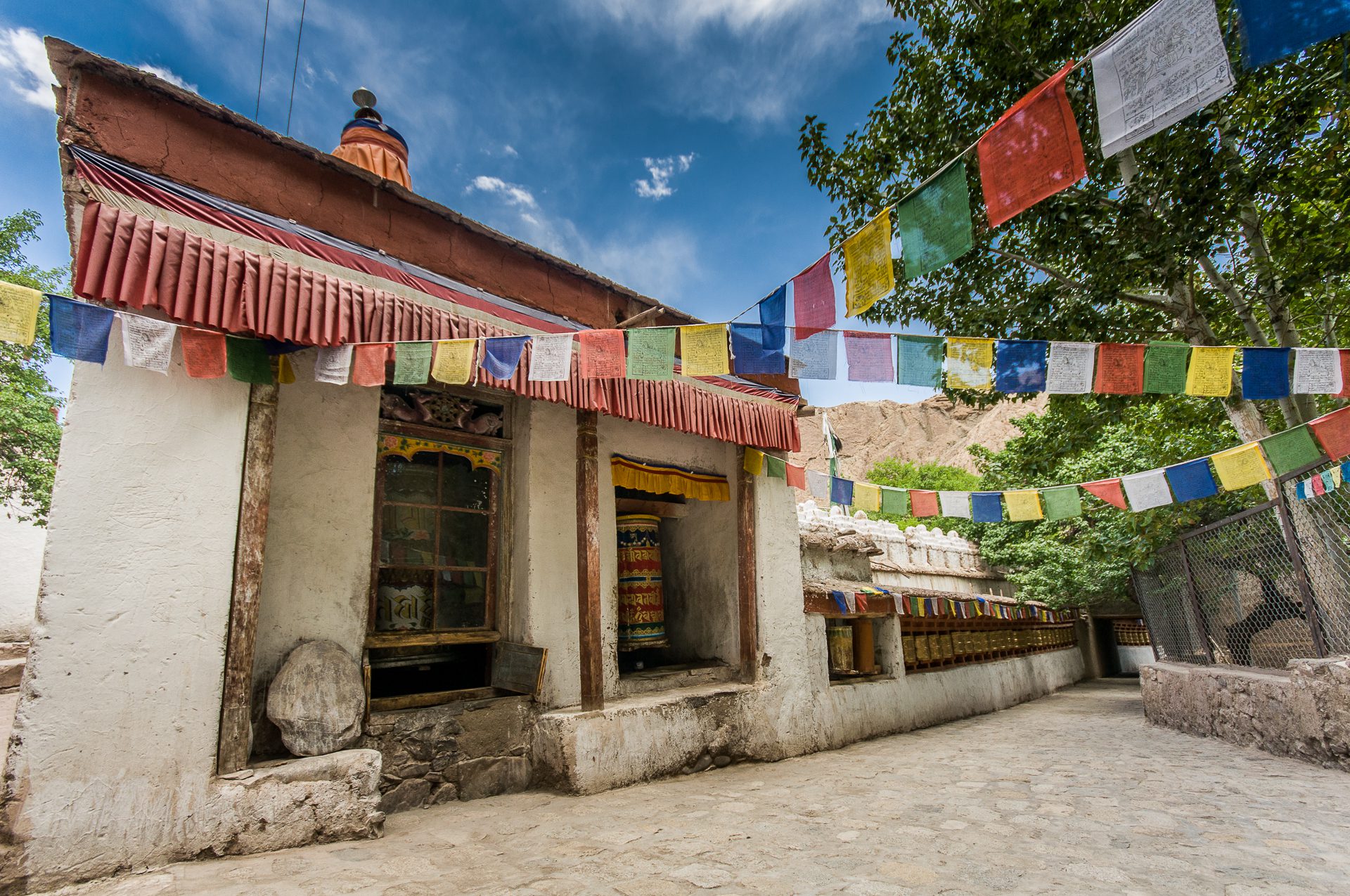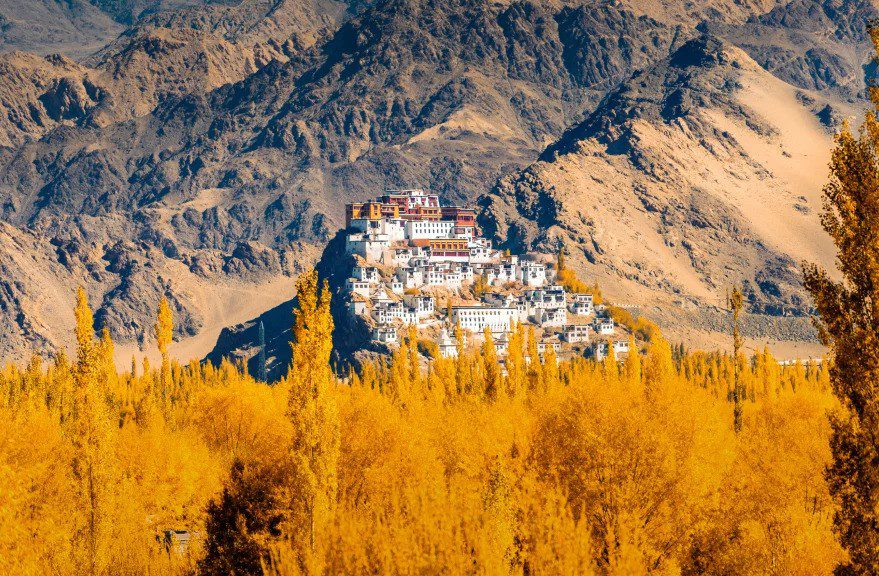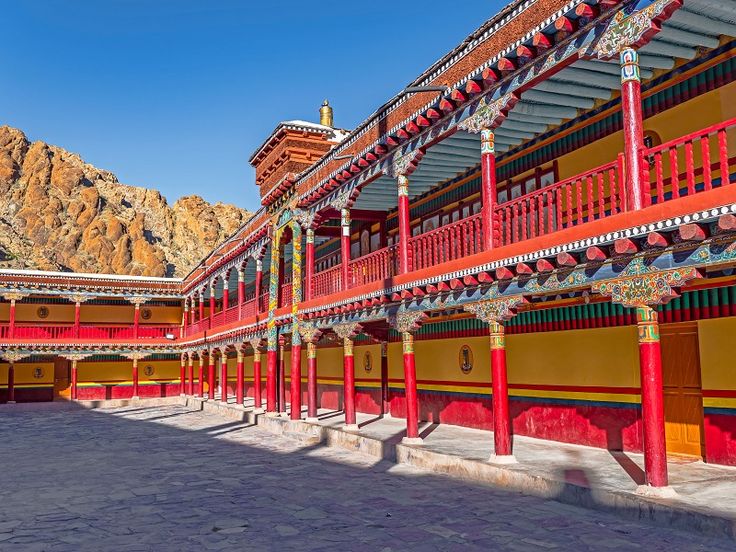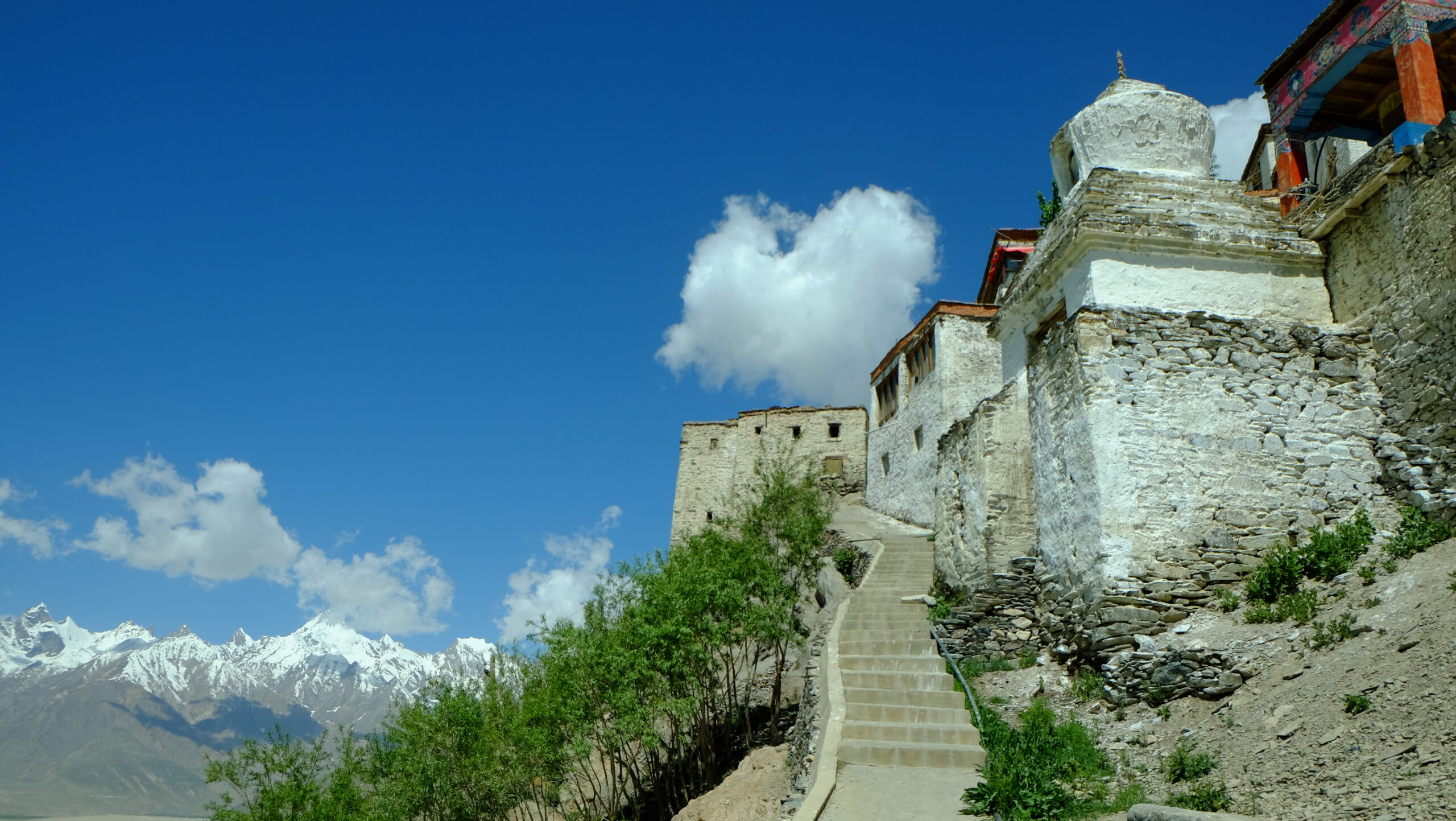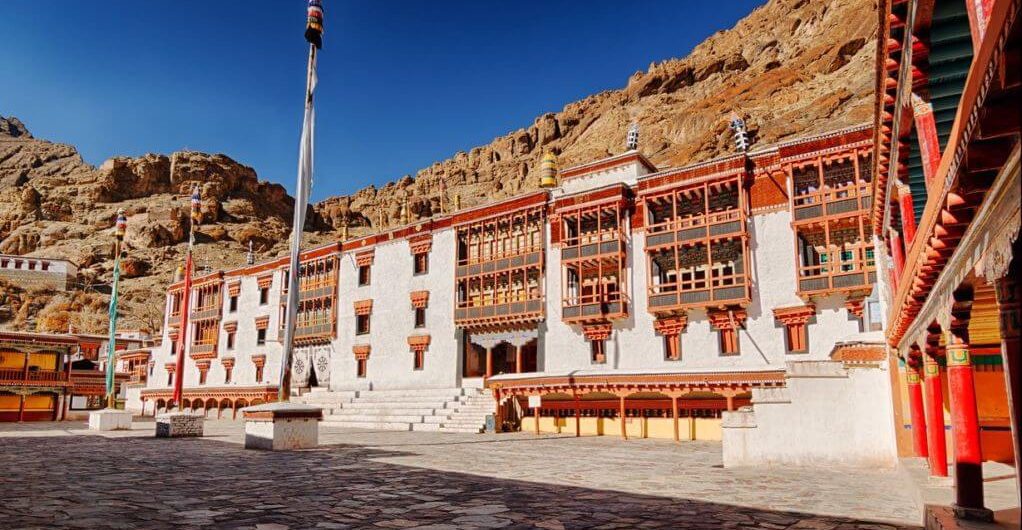Nestled in the serene Himalayan terrain, Ladakhi monasteries are not just places of worship but also extraordinary examples of architectural brilliance. Their design embodies the principles of sacred geometry, reflecting Buddhist cosmology and spiritual beliefs. These monasteries combine intricate symmetry, geometric patterns, and spiritual alignments to create an atmosphere of peace and enlightenment.
In this blog, we’ll explore the unique architectural elements, spiritual significance, and efforts to preserve these marvels of sacred geometry.
1. Introduction to Ladakhi Monasteries
The Unique Blend of Religion and Architecture
Ladakhi monasteries, or “gompas,” are awe-inspiring manifestations of the Buddhist philosophy they house. These structures harmoniously blend spiritual purpose with architectural ingenuity, standing as symbols of devotion, resilience, and artistic excellence.

“When I visited Hemis Monastery, the architectural symmetry left me speechless. It felt like stepping into a realm where every structure resonated with spiritual energy.”
— Sophia Williams, Architect, USA
Geographic Significance of Ladakh in Monastic Architecture
The Himalayan landscape greatly influences monastic architecture. Positioned on hilltops or cliff edges, monasteries align with the natural contours, symbolizing humanity’s connection to the cosmos. Their locations often adhere to principles of Feng Shui, creating harmony with the surrounding environment.
2. The Concept of Sacred Geometry in Buddhist Architecture
Understanding Sacred Geometry in Monastic Layouts
Sacred geometry is the spiritual foundation of Buddhist architecture. It uses proportions and patterns, such as mandalas, to reflect universal harmony. In Ladakhi monasteries, layouts and designs are often based on precise geometric principles to create spaces conducive to meditation and enlightenment.

How Geometry Reflects Spiritual Beliefs
Each monastery’s layout serves a symbolic purpose. For instance, the concentric designs of mandalas represent the universe’s structure, guiding practitioners on a spiritual journey toward liberation.
3. Architectural Elements of Ladakhi Monasteries
Symmetry in Monastic Design: Spiritual and Practical Purposes
Symmetry is not just an aesthetic choice but a spiritual necessity in monastery architecture. Balanced layouts symbolize equilibrium in life, a core Buddhist teaching. Monastic spaces, such as prayer halls and courtyards, are designed symmetrically to foster a sense of peace and focus.

“I’ve studied architectural designs worldwide, but the symmetry of Thiksey Monastery stands out. Every detail feels intentional and spiritually uplifting.”
— David Klein, Engineer, Germany
The Role of Mandalas and Geometric Patterns
Mandalas influence not only the monastery layouts but also the frescoes and decorative elements. These patterns serve as tools for meditation and represent the cosmos in a microcosm, emphasizing interconnectedness.
Chorten Structures and Their Symbolism
Chortens (stupas) are quintessential to Buddhist architecture. Their design incorporates sacred geometric principles, often symbolizing the five elements: earth, water, fire, air, and space. These structures serve as reminders of impermanence and spiritual transcendence.
4. Famous Monasteries Showcasing Sacred Geometry
Thiksey Monastery: An Architectural Marvel
Thiksey Monastery, resembling the Potala Palace in Tibet, is a twelve-story complex built on a hilltop. Its tiered structure mirrors Buddhist cosmology, with higher levels representing spiritual ascension. The monastery houses a magnificent Maitreya Buddha statue, perfectly aligned within the complex to exude balance and serenity.
Key Architectural Features of Thiksey Monastery:
- Main Assembly Hall: Symmetrically designed for community prayer.
- Statue of Maitreya Buddha: Positioned to signify the future Buddha’s arrival.
- Meditation Halls: Geometric layouts for introspection.
Hemis Monastery: Spiritual and Artistic Grandeur
Known for its annual Hemis Festival, this monastery is a masterpiece of geometric and artistic design. Its courtyard, adorned with vibrant frescoes, showcases symmetry and spiritual motifs, drawing parallels to the Buddhist path of enlightenment.

Alchi Monastery: Ancient Frescoes and Sacred Design
Alchi Monastery, one of Ladakh’s oldest, is renowned for its ancient frescoes and paintings. Its architectural elements, such as mandala-based floor plans, reflect a blend of Indian and Tibetan influences, highlighting sacred geometry’s timeless appeal.
5. Spiritual Significance of Ladakhi Monastery Layouts
Meditation Spaces and Symmetrical Alignments
Meditation spaces in monasteries are carefully designed using sacred geometry to create an environment of balance and tranquility. Symmetry in these spaces enhances focus, guiding practitioners toward spiritual awakening.

Prayer Halls and Their Symbolic Positioning
Prayer halls, central to monastery life, are strategically placed to symbolize unity and spiritual alignment. Their positioning often mirrors cosmic structures, connecting devotees to the universe’s rhythm.
Symbolism in Staircases, Entrances, and Pathways
The staircases and pathways leading to monasteries are more than functional elements; they symbolize the spiritual journey. Ascending these paths is akin to progressing toward enlightenment, with every step imbued with meaning.
6. Preservation of Ladakhi Monasteries
Cultural and Historical Importance
Ladakhi monasteries are not just religious sites but cultural treasures, preserving centuries of art, tradition, and Buddhist philosophy. Their designs inspire architects, artists, and spiritual seekers worldwide.
“As a historian, I found the preservation efforts in Ladakh inspiring. Every monastery tells a story of spiritual and cultural resilience.”
— Elizabeth Norton, Historian, UK
Challenges in Maintaining Architectural Integrity
These monasteries face threats from natural erosion, climate change, and unregulated tourism. Balancing preservation with modern needs is a delicate task, requiring international collaboration and local dedication.

Modern Efforts to Protect Sacred Geometry in Ladakh
Organizations like UNESCO and local Buddhist communities actively work to restore and preserve the sacred geometry of Ladakhi monasteries. These initiatives ensure the continuation of their spiritual and architectural legacy.
7. Conclusion: Harmony Between Architecture and Spirituality
Ladakhi monasteries exemplify the union of sacred geometry and spirituality, demonstrating how architectural precision can deepen spiritual experiences. As symbols of harmony and enlightenment, these structures inspire both awe and introspection. Preserving them is not just an act of conservation but a commitment to protecting humanity’s shared spiritual heritage.
“Visiting Ladakhi monasteries changed my perspective on architecture. They embody a spirituality that modern designs often lack.”
— Arjun Menon, Interior Designer, India
FAQs
Q1: What is the significance of sacred geometry in Ladakhi monasteries?
Sacred geometry reflects the universal harmony and spiritual beliefs of Buddhism, creating balanced and serene spaces for meditation and worship.
Q2: Which are some famous monasteries in Ladakh that showcase sacred geometry?
Thiksey, Hemis, and Alchi monasteries are renowned for their intricate geometric layouts and spiritual alignment.
Q3: How does symmetry play a role in monastic architecture?
Symmetry symbolizes balance and harmony, core principles of Buddhist teachings, and enhances spiritual focus.
Q4: What challenges do Ladakhi monasteries face in preservation?
Climate change, natural erosion, and unregulated tourism pose significant threats to their architectural integrity.
Q5: Are there efforts to preserve Ladakhi monasteries?
Yes, organizations like UNESCO and local Buddhist communities are actively involved in restoration and preservation.
Sacred Geometry of Ladakhi Monasteries
Sacred Geometry of Ladakhi Monasteries | The journey through Ladakh mirrors the very essence of unraveling unknown horizons, as its dramatic landscapes and unique cultural identity awaken the deepest sense of wonder and exploration. Sacred Geometry of Ladakhi Monasteries delves into this realm where inner peace intertwines with the wild, untouched beauty of Ladakh. From the snow-capped peaks to the serene monasteries, every step in Ladakh is a step toward self-discovery. The mountains, ancient paths, and unspoken mysteries stretch before travelers, offering a meditative experience where each encounter feels both effortless and transformative. Whether it’s trekking across remote valleys or sitting quietly beside a sacred lake, Ladakh invites those who seek a deeper connection to the natural and spiritual world.

Sacred Geometry of Ladakhi Monasteries
The monasteries of Ladakh stand as living monuments to the region’s profound spiritual heritage. With origins dating back over a thousand years, these ancient structures are both places of worship and repositories of art, culture, and wisdom. Hemis Monastery, one of the largest in Ladakh, is renowned for its annual festival, featuring colorful mask dances performed by monks. The history of these monasteries reflects Ladakh’s role as a crossroads between India, Tibet, and Central Asia, where religious and cultural influences have intertwined over the centuries.
The Tibetan Buddhist influence is especially evident in the architecture and daily life of the monks. Prayer wheels, intricate murals, and the soft hum of chants fill the air as visitors explore the monastery grounds. Each monastery, from the remote Lamayuru to the awe-inspiring Thiksey, offers a window into the spiritual heart of Ladakh. These centers of meditation, learning, and community life continue to thrive, preserving traditions that have shaped Ladakh for generations.
Why Visit Ladakh for Sacred Geometry of Ladakhi Monasteries?
Ladakh is a destination that transcends mere travel. It offers a journey that touches both the outer and inner landscapes, making it a perfect setting for those who seek to unravel their own unknown horizons. The region’s breathtaking scenery—from towering mountain ranges to hidden valleys—provides not just an escape but a space for contemplation and growth. Ladakh’s culture, deeply rooted in Buddhist practices, invites visitors to reflect on their own lives and the world around them.
Ladakh’s people, known for their warmth and hospitality, add to the richness of the experience. Villages like Sumda Chun and the legendary Nubra Valley introduce travelers to a way of life that is intricately connected to nature and spirituality. Staying in local homestays allows for immersive experiences where one can learn about traditional Ladakhi customs, share meals made from local produce, and participate in community rituals.

Beyond its natural beauty, Ladakh offers a unique opportunity to explore oneself. The vastness of the region’s plateaus and the clarity of its skies seem to mirror the vastness of the human spirit. Whether it’s standing atop a mountain pass at 18,000 feet or meditating in a centuries-old monastery, Ladakh helps unravel the unknown horizons within each traveler.
Finding the Best Sacred Geometry of Ladakhi Monasteries in Ladakh
Finding the best places in Ladakh to experience “Sacred Geometry of Ladakhi Monasteries” involves venturing off the beaten path. Ladakh’s lesser-known treks, such as those leading to secluded monasteries or high-altitude lakes, offer unparalleled opportunities for solitude and reflection. The Markha Valley trek, for instance, takes travelers through verdant valleys, ancient villages, and high-altitude passes, allowing for both physical and spiritual exploration.
Ladakh’s iconic lakes, including Pangong Tso and Tso Moriri, are ideal spots for quiet contemplation. Their still waters reflect the sky, creating a mesmerizing landscape that feels timeless and infinite. Sitting beside these lakes, especially at dawn or dusk, brings an overwhelming sense of peace and connection with nature.

For those interested in Ladakh’s spiritual heritage, exploring monasteries such as Alchi, Phyang, or Diskit can be a transformative experience. These sites are not just places of worship but also centers of art, philosophy, and wisdom. Visiting these monasteries, with their ancient murals and intricate statues, offers insight into Ladakh’s rich cultural tapestry.
Ladakh’s Atmosphere and Sacred Geometry of Ladakhi Monasteries
Ladakh’s atmosphere is unlike any other place on Earth. The stark contrasts between the rugged mountains and the serene, tranquil monasteries create an environment that feels both raw and sacred. The traditional decor in Ladakhi homes and religious sites reflects this balance, with mud-brick houses adorned with prayer flags and colorful thangkas (Buddhist paintings) that add warmth and spiritual meaning to the space.

The interiors of Ladakhi homes, often simple and functional, are filled with symbols of devotion. Small shrines dedicated to Buddhist deities are common, and the air is often fragrant with incense. The use of earthy materials, like stone and wood, along with brightly colored textiles, creates an inviting and peaceful space, perfect for relaxation and reflection.
Traditional Sacred Geometry of Ladakhi Monasteries
Traditional Sacred Geometry of Ladakhi Monasteries is an integral part of the region’s identity, offering a unique blend of flavors that reflect its harsh climate and remote location. Hearty, warming dishes such as thukpa (noodle soup) and momos (dumplings) provide the sustenance needed to endure Ladakh’s cold temperatures. Skyu, a thick stew made with root vegetables and barley, is another staple of the Ladakhi diet, designed to nourish both body and spirit.

Drinks like butter tea, made with yak butter and salt, are a must-try for anyone visiting Ladakh. This rich, savory drink is not only warming but also hydrating, making it essential for those venturing into the high-altitude regions of Ladakh. Chang, a local barley beer, is often enjoyed during festivals and community gatherings, adding a sense of joy and camaraderie to any occasion.
Live Cultural Sacred Geometry of Ladakhi Monasteries in Ladakh
Ladakh is home to a vibrant cultural scene, with festivals and live performances held throughout the year. The Hemis Festival, which celebrates the birth of Guru Padmasambhava, is one of the largest and most famous events in the region. Monks dressed in elaborate costumes perform cham dances, which depict the triumph of good over evil. The energy of the festival, with its bright colors, rhythmic music, and elaborate rituals, draws visitors from around the world.
Other local festivals, such as the Losar (New Year) and Ladakh Festival, provide visitors with the chance to witness traditional dance, music, and crafts that have been passed down through generations. These events are more than just entertainment; they are a celebration of Ladakh’s rich cultural heritage and its deep connection to the spiritual world.
Trekking and Outdoor Activities Sacred Geometry of Ladakhi Monasteries
Ladakh is a trekker’s paradise, offering some of the most stunning and challenging routes in the world. From the famous Sacred Geometry of Ladakhi Monasteries, which follows the frozen Zanskar River, to lesser-known routes like the Sham Valley or Nubra Valley treks, Ladakh’s landscape offers endless possibilities for adventure and discovery. The high-altitude passes, such as Khardung La and Chang La, offer breathtaking views of snow-capped peaks and sprawling valleys.

Wildlife enthusiasts will also find Sacred Geometry of Ladakhi Monasteries to be a haven for rare species such as the snow leopard, Himalayan blue sheep, and the Tibetan wild ass. Winter expeditions to spot the elusive snow leopard in the Hemis National Park are gaining popularity among wildlife photographers and conservationists alike.
The Importance of Preserving Ladakh’s Sacred Geometry of Ladakhi Monasteries
Ladakh’s rich cultural and environmental Sacred Geometry of Ladakhi Monasteries is under increasing threat from climate change and mass tourism. Preserving this unique region requires careful attention to sustainable tourism practices. Choosing eco-friendly accommodations, supporting local businesses, and participating in community-led conservation efforts are just a few ways that visitors can contribute to the preservation of Ladakh’s natural and cultural heritage.
Ladakh’s people have a long history of living in harmony with their environment, practicing sustainable agriculture, and maintaining a deep spiritual connection to the land. Visitors are encouraged to follow the same principles, leaving no trace and respecting the fragile ecosystems that make Ladakh so special.
Etiquette and Tips for Visiting Sacred Geometry of Ladakhi Monasteries
Before visiting Ladakh, it’s essential to understand and respect the region’s customs and traditions. As a deeply spiritual place, Ladakh requires visitors to dress modestly, especially when visiting monasteries or attending religious ceremonies. Always ask for permission before taking photographs inside monasteries or of local people.
Medical Sacred Geometry of Ladakhi Monasteries
Spa trail Sacred Geometry of Ladakhi Monasteries
Sacred Geometry of Ladakhi Monasteries

When Sacred Geometry of Ladakhi Monasteries, remember to stay on designated paths to avoid damaging fragile ecosystems. Tipping is appreciated but not expected in most settings, and it’s important to carry cash, as many remote areas do not accept credit cards. Lastly, be mindful of altitude sickness and take the necessary precautions when traveling to higher elevations.
Conclusion: Enjoying Sacred Geometry of Ladakhi Monasteries in Ladakh
Ladakh is a place where the physical and spiritual worlds converge, offering travelers a journey unlike any other. Whether you’re trekking across high-altitude deserts, exploring ancient monasteries, or simply sitting in quiet reflection by a mountain lake, Ladakh invites you to unravel your own unknown horizons. By respecting the region’s traditions and practicing sustainable tourism, you help ensure that Ladakh’s beauty and cultural richness will be preserved for future generations to explore and enjoy.
